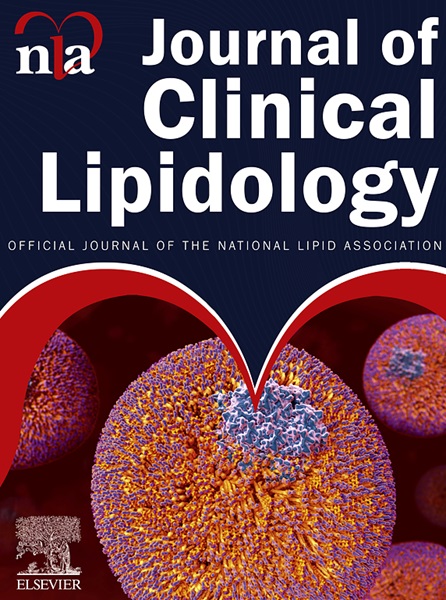Long-term lipoprotein apheresis reduces cardiovascular events in high-risk patients with isolated lipoprotein(a) elevation
IF 3.6
3区 医学
Q2 PHARMACOLOGY & PHARMACY
引用次数: 0
Abstract
BACKGROUND
Elevated lipoprotein(a) (Lp(a)) is an established risk factor for cardiovascular disease (CVD). To date, the only approved treatment to lower Lp(a) is lipoprotein apheresis (LA). Previous studies have demonstrated that LA is effective in reducing cardiovascular (CV) risk in patients with elevated low-density lipoprotein cholesterol (LDL-C) and/or Lp(a). Here we report our long-term experience with LA and its effectiveness in reducing CVD events in patients with elevated Lp(a).
METHODS
This retrospective open-label, single-center study included 25 individuals with Lp(a) elevation >60 mg/dL and LDL-C < 2.59 mmol/L who had indication for LA. The primary endpoint of this study was the incidence of any CV event (determined by medical records) after initiation of LA.
RESULTS
Mean LA treatment duration was 7.1 years (min-max: 1–19 years). Median Lp(a) was reduced from 95.0 to 31.1 mg/dL after LA (-67.3%, p < 0.0001). Mean LDL-C was reduced from 1.85 to 0.76 mmol/L after LA (-58.9%, p < 0.0001). Prior to LA, 81 CV events occurred in total (0.87 events/patient/year). During LA, 49 CV events occurred in total (0.24 events/patient/year; -0.63, p = 0.001). Yearly major adverse cardiac event (MACE) rate was reduced from 0.34 to 0.006 (-0.33, p = 0.0002). Similar results were obtained when considering only individuals with baseline LDL-C below 1.42 mmol/L.
CONCLUSION
In this observational study of a heterogeneous CV high-risk cohort with elevated Lp(a), LA reduced Lp(a) levels and was paralleled by a decrease in CV events and MACE. We recommend LA for patients with high Lp(a) who still have CV events despite optimal lipid-lowering medication and lifestyle changes.
长期脂蛋白清除术可降低孤立脂蛋白(a)升高的高危患者的心血管事件发生率
脂蛋白(a)(Lp(a))升高是心血管疾病(CVD)的既定风险因素。迄今为止,唯一获得批准的降低脂蛋白(a)的治疗方法是脂蛋白分离术(LA)。以往的研究表明,LA 能有效降低低密度脂蛋白胆固醇(LDL-C)和/或脂蛋白(a)升高患者的心血管(CV)风险。在此,我们报告了使用 LA 的长期经验及其在降低脂蛋白(a)升高患者心血管事件方面的有效性。这项回顾性开放标签单中心研究纳入了 25 名 Lp(a) 升高 >60 mg/dL、LDL-C < 2.59 mmol/L 且有 LA 适应症的患者。该研究的主要终点是开始使用 LA 后任何 CV 事件的发生率(根据医疗记录确定)。LA治疗的平均持续时间为7.1年(最小值-最大值:1-19年)。LA 治疗后,脂蛋白(a)中位数从 95.0 mg/dL 降至 31.1 mg/dL (-67.3 %, < 0.0001)。LA 后,平均 LDL-C 从 1.85 mmol/L 降至 0.76 mmol/L(-58.9%,< 0.0001)。LA 前,共发生 81 起 CV 事件(0.87 起/患者/年)。在 LA 期间,共发生 49 起 CV 事件(0.24 起/患者/年;-0.63,=0.001)。主要心脏不良事件(MACE)年发生率从0.34降至0.006(-0.33,=0.0002)。如果只考虑基线 LDL-C 低于 1.42 mmol/L 的个体,也能获得类似的结果。在这项针对 Lp(a) 升高的异质性冠心病高危人群的观察性研究中,LA 可降低 Lp(a) 水平,同时减少冠心病事件和 MACE。我们建议 Lp(a) 高的患者在服用最佳降脂药物和改变生活方式后仍发生 CV 事件的情况下使用 LA。
本文章由计算机程序翻译,如有差异,请以英文原文为准。
求助全文
约1分钟内获得全文
求助全文
来源期刊
CiteScore
7.00
自引率
6.80%
发文量
209
审稿时长
49 days
期刊介绍:
Because the scope of clinical lipidology is broad, the topics addressed by the Journal are equally diverse. Typical articles explore lipidology as it is practiced in the treatment setting, recent developments in pharmacological research, reports of treatment and trials, case studies, the impact of lifestyle modification, and similar academic material of interest to the practitioner.
Sections of Journal of clinical lipidology will address pioneering studies and the clinicians who conduct them, case studies, ethical standards and conduct, professional guidance such as ATP and NCEP, editorial commentary, letters from readers, National Lipid Association (NLA) news and upcoming event information, as well as abstracts from the NLA annual scientific sessions and the scientific forums held by its chapters, when appropriate.

 求助内容:
求助内容: 应助结果提醒方式:
应助结果提醒方式:


